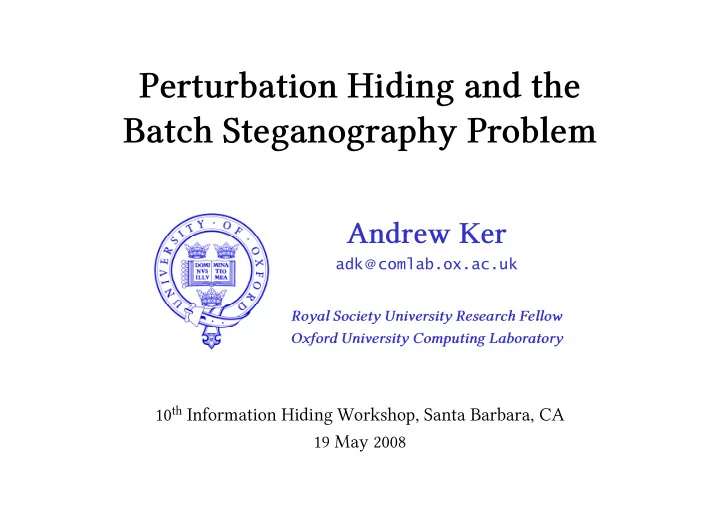

Perturbation Hiding and the Batch Steganography Problem Andrew Ker ��� @ ��������������� ���������������������������������������� �������������������������������������� 10 th Information Hiding Workshop, Santa Barbara, CA 19 May 2008
Perturbation Hiding and the Batch Steganography Problem Outline • ����������������������� ������� • ������! • "���#�����$ ��������� • ������������������ • ������������ • �����������
Batch Steganography ‣ ������������������������������������������� A. Ker, Batch Steganography & Pooled Steganalysis, Proc. 8 th Information Hiding Workshop, 2006.
Alice Bob Warden payload: m bits is the distribution of embedding extraction objects with cover m bits embedded secret key
? Alice Bob Warden payload: m bits embedding extraction cover secret key
any ? Alice Bob Warden payload: m bits … embed λ 1 bits embed λ 2 bits embedding extraction n covers …… …… …… embed λ n bits secret key
Alice Bob Warden payload: m bits … embed λ 1 bits embed λ 2 bits n covers embedding extraction …… …… … … embed λ n bits secret key The Batch Steganography Problem How should Alice distribute her payload between the covers, to make detection as difficult as possible? ‣ �����%�����������������������������������������������������& ‣ ����������������������������������������������#!
Analysing Batch Steganography Can fix a particular behaviour for Warden and optimize with respect to that, e.g. [1], [2]. ‣ ����������������������������������������& Alternatively, consider where We can seek to minimize the KL divergence, e.g. [3]. ‣ ����������������������������& [1] A. Ker, Batch Steganography & Pooled Steganalysis, Proc. 8 th Information Hiding Workshop, 2006. [2] A. Ker, Batch Steganography & the Threshold Game, Proc. SPIE/IS&T Electronic Imaging, 2007. [3] A. Ker, Steganographic Strategies for a Square Distortion Function, Proc. SPIE/IS&T Electronic Imaging, 2008.
Paradox! Hide m bits in one object out of n , in independent covers: one all other which is independent of n ! ‣ '�������������������(������ ��)�������(*������(����(***�!+ The problem is that KL divergence bounds the performance of simple hypothesis tests. For batch steganography, we have '���������������������� H � : all H � : some but we measured the security of ,���������-�#����-������������ H � : all H � :
Kerckhoffs’ Principle “It must not be necessary to keep the system secret: it should not cause trouble if it falls into enemy hands.” (But we do not assume that the enemy knows the secret crypto key!) Often coupled with ����������������������� or the .����/0��������� for protocol analysis. What motivates these pessimistic assumptions? ������������-����������������������������������������������& In steganography, what should we grant the Warden? � Complete knowledge of embedding algorithm. � Complete knowledge of cover source. � Complete knowledge of the payload.
cover payload: m bits Alice embedding encryption secret key Bob decryption extraction
Kerckhoffs’ Principle “It must not be necessary to keep the system secret: it should not cause trouble if it falls into enemy hands.” (But we do not assume that the enemy knows the secret crypto key!) Often coupled with ����������������������� or the .����/0��������� for protocol analysis. What motivates these pessimistic assumptions? ������������-����������������������������������������������& In steganography, what should we grant the Warden? � Complete knowledge of embedding algorithm. � Complete knowledge of cover source. � Complete knowledge of the payload. Knowledge of size of payload. �
Options for Warden’s Knowledge In batch steganography, what should we grant the opponent? Complete knowledge of embedding algorithm for individual objects. � Complete knowledge of cover source. � � Complete knowledge of the payload. Knowledge of size of payload… � 1. The sizes of the individual payload chunks in each cover. 2. The sizes of the individual payload chunks, but not their � correspondence with covers. ? 3. The total size of payload, but not its division into chunks.
The Perturbation Hiding Problem Suppose a fixed oneEparameter family of probability distributions defined for an integer and a constant We must choose a nonnegative vector of parameters subject to to minimize where are iidrv with distribution are independent with distributions with drawn uniformly at random from ��������������������������������������������������������������1������� ������&
Theorem 1 If is an exponential family with a natural reparameterization, the natural parameter is convex nondecreasing, and the variance nondecreasing, in then the solution to the perturbation hiding problem is i.e. spread payload equally amongst all covers. 2�����������������������������1���������������������������������#�������� 3������������������������������������������������& One such case is when is convex and monotonic.
Numerical Results For distributions which are not an exponential family, we would like to explore the problem numerically. But can only be estimated for very small n .
Numerical Results Let be a t Edistribution with df parameter ν and location parameter λ . The ν parameter controls the weight of the tails: small heavy tails large light tails ‣ ,�������������%����������������������������������������������������
Numerical Results Let be a t Edistribution with df parameter ν and location parameter λ . The ν parameter controls the weight of the tails: small heavy tails large light tails ‣ ,�������������%���������������������������������������������������� 4 ����������������������������������������+
Theorem 2 Assuming sufficient regularity, as we have ����� ����������������%����� ������������������������������� ��������������������������
Conclusions • The Perturbation Hiding problem is a mathematical abstraction of batch steganography. 2���������������������������������������������������������������/���������� ��������������������& • It has been solved for the case of convex exponential families, and we have explored its asymptotics for small payloads. ����������#5 ‣ ���������� ������- ‣ ����������� �����������& • We must be careful about the information asymmetry in the batch steganography problem. "���#�����$ ���������������������������������������������������������-� ���������������������������������������&
End ��� @ ���������������
Recommend
More recommend